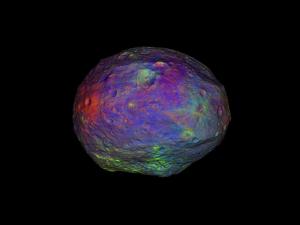Post
Color Kin
28 May 2013
 NASA/JPL-Caltech/UCLA/MPS/DLR/IDA/PSI
NASA/JPL-Caltech/UCLA/MPS/DLR/IDA/PSIWe generally think of asteroids as looking like gray rocks. While that’s true to our limited eyes, more sensitive instruments find they have a variety of colors. You can see an example of this in the image above of the asteroid Vesta. This false color image was made by observing Vesta at various wavelengths in the visible and infrared spectrum. It shows that Vesta has variations in color too subtle for us to see with our eyes.
The color variation is caused by the varying composition of Vesta. The green regions, for example, indicate the presence of iron. While Vesta is the only asteroid with such detailed color observations, other asteroids have been observed at different wavelengths to determine their overall color. It turns out the color of an asteroid correlates well with the family it is a part of.
Asteroids aren’t just scattered randomly through the asteroid belt. Because of the gravitational interactions of Jupiter and the other planets, asteroids tend to be clumped into groups or families. In 2002, the Sloan Digital Sky Survey (SDSS) observed more than 10,000 asteroids at different wavelengths to determine their overall color. What was found was that there was less color variation within a particular family than their was between families.1
Asteroid families are defined by the similarity of their orbits. What this study showed is that asteroid families also share similar coloring. Since the coloring of an asteroid is determined by its composition, this means asteroid families have similar compositions. Asteroid families are chemically similar.
This has important consequences for the history of our solar system. It means that asteroid families formed within their own family. They didn’t form first and then get pushed into groups by the gravitational tugs of the planets. This means the orbital dynamics of the solar system likely stabilized before the asteroids formed.
Ivezić, Željko, et al. “Color confirmation of asteroid families.” The Astronomical Journal 124.5 (2002): 2943. ↩︎